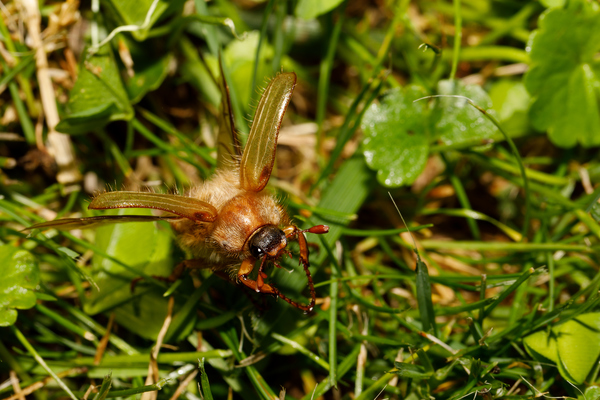
Showing 44 types of BEETLES (TURF & ORNAMENTAL)
Latin Name: Listronotus maculicollis
This is a native insect in the northeastern United States, and now found in the southeastern Provinces of Canada.
Latin Name: Anoplophora glabripennis
This beetle is native to eastern Asia in the regions of China, Korea, and Japan. While it now is a resident species in New York, New Jersey, and upper Illinois it has been found, and hopefully eradicated, in CA, WA, TX, FL, and many other states east of the Mississippi River, as well as on the island of Hawaii. It has been found living in wood packing materials shipped from Asia.
Latin Name: Maladera castanea
This is a native of Asia, but it was discovered in 1921 in New Jersey, and now is found commonly in a few Northeast states and occasionally south into South Carolina.
Latin Name: Otiorhynchus sulcatus
It is believed that this beetle is native to northern Europe, but it has been present in North America since at least 1835. It now is found throughout the world.
Latin Name: Diaprepes abbreviatus
It is believed that this beetle is native to the Caribbean, and was imported into the U.S. around 1960 on plants from Puerto Rico. It now infests the Southeast U.S. west to Texas and on a regular basis is intercepted in shipments of plants in California.
Latin Name: Xanthogaleruca luteola
This beetle is native to Europe but is now found throughout North America, having first been detected in Maryland in the 1830’s.
Latin Name: Agrilus planipennis
It is a native of eastern Asia and is believed to have entered North America in wood packaging materials.
Latin Name: Ips sp.
These are native species that are found throughout North America.
Latin Name: Trachymela sloanei
These two beetles are native to Australia, but were discovered in California in 1998 and 2003.
Latin Name: Phoracantha semipunctata
Native to Australia and introduced in 1984 to California.
Latin Name: Rhizotrogus majalis
This is likely a European species that was first discovered in North America in 1940 in New York. It now occupies all of the Upper Northeast states and into Ontario, Canada.
Latin Name: Disonycha sp. / Capraita sp.
These are primarily native insects in North America.
Latin Name: Naupactus cervinus
It is believed this beetle is native to Central and South America, but now well established across the U.S. and throughout the world, with occasional occurrences in southern Canada. It’s presence on plants being shipped from California to Japan has caused those shipments to be turned away and quarantines to be put in place.
Latin Name: Agrilus auroguttatus
The gold-spotted oak borer is native to southeastern Arizona and a very similar species – Agrilus coxalis – is found in central Mexico to Guatemala.
Latin Name: Cotinis sp.
These are native beetles in North America, with C. nitida occurring in the eastern U.S. and C. mutabilis occurring in the western U.S. and Mexico. Both species may occur in Texas.
Latin Name: Popillia japonica
This terrible pest is a native of Japan, but was first discovered in the U.S. in 1916 in New Jersey. It now occupies and heavily infests the entire Northeast U.S. and southeastern Canada, with the Mississippi River about its western border.
Latin Name: Chrysolina quadrigemina
These beetles are native to Northern Africa and Europe.
Latin Name: Polyphylla sp.
At least 2 dozen of these native beetles occur in North America.
Latin Name: Phyllophaga sp.
At least 152 species in the genus Phyllophaga occur as native insects in the United States and Canada, most in the eastern half of the U.S., and according to some sources there may be up to 400 species in North America. There are 100 species in Texas.
Latin Name: Dendroctonus ponderosae
This beetle is a native insect in western North America, from Mexico to British Columbia.
Latin Name: Sciopithes obscurus
This is a native species in the Pacific Northwest of the U.S.
Latin Name: Anomala orientalis
This beetle is native to eastern Asia and was introduced into the Hawaiian Islands on the island of Oahu before 1908, where it has been a serious pest of sugarcane. It was then found in the mainland U.S. in 1920 in Connecticut, presumably in nursery stock from Japan. It now ranges from North Carolina to the New England states.
Latin Name: Euplatypus sp.
About 7 species of these native beetles occur in North America and are found throughout the U.S. and into southern Canada.
Latin Name: Conotrachelus nenuphar
This is a native species that is widely distributed east of the Rocky Mountains in North America.
Latin Name: Dendroctonus valens
This species is a native insect in North America and now is also found as an invasive in China.
Latin Name: Xylobiops basilaris
This is a native insect in the eastern half of North America.
Latin Name: Merhynchites bicolor
A native beetle in western North America, and found throughout the continent, but primarily in the northern states and southern Canada, and most common in the West.
Latin Name: Chalcophora virginiensis
A native species in eastern North America.
Latin Name: Xyleborus sp.
Most species in North America are native insects, with several species introduced from Europe.
Latin Name: Scolytus multistriatus
True to its name this beetle is native to Europe and northern Asia, but it now is found throughout North America wherever elm tree hosts occur.
Latin Name: Otiorhynchus ovatus
It is native to Europe but now found throughout North America, and is a serious agricultural pest in the Pacific Northwest.
Latin Name: Pseudocneorhinus bifasciatus
Native to eastern Asia and the Orient, but introduced as early as 1914 in Pennsylvania, and it now occurs and is established along the east coast of the U.S.
Latin Name: Agrilus bilineatus
This is a native species in eastern North America.
Latin Name: Chrysomela interrupta
This is a native beetle in North America, and is found from Alaska south to California and east into much of the rest of the U.S. and Canada.